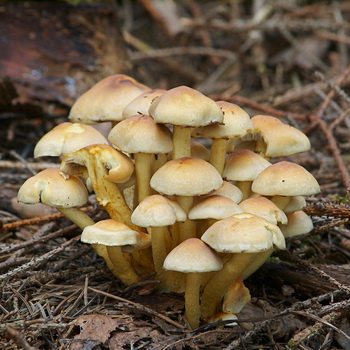False mushrooms sulfur-yellow mushrooms: edible or poisonous mushrooms sulfur-yellow mushrooms?
 Honey mushrooms are called so because they grow on stumps, fallen trees, as well as on rotten or dead wood of deciduous trees. Only meadow honey does not grow in the forest, but in grassy areas: forest glades, fields, gardens or roadsides. Although there are about thirty species of honey agarics, mushroom pickers divide them into summer, autumn and winter groups. Most of the honey agarics can be safely eaten.
Honey mushrooms are called so because they grow on stumps, fallen trees, as well as on rotten or dead wood of deciduous trees. Only meadow honey does not grow in the forest, but in grassy areas: forest glades, fields, gardens or roadsides. Although there are about thirty species of honey agarics, mushroom pickers divide them into summer, autumn and winter groups. Most of the honey agarics can be safely eaten.
It is worth saying that in addition to edible and conditionally edible "relatives", honey fungus also has a poisonous false twin - sulfur-yellow honey fungus. If conditionally edible ones are used for food, then they are pre-soaked, then boiled, and only then dishes are prepared from them. However, poisonous false counterparts can pose a health hazard. We offer you to see a photo of a sulfur-yellow honey fungus and compare it with real mushrooms.
Some novice mushroom pickers often ask the question: is sulfur-yellow honey fungus edible? Let's answer right away - no, although it is very similar to a real summer honey agaric. In addition, the fruiting of a false honey fungus is the same as that of its summer "relative". They also grow on stumps and dead wood in large families, mainly in deciduous forests.
What does a sulfur-yellow mushroom look like?
To find out what this mushroom looks like, check out the description of the sulfur-yellow false mushroom with a photo.
Latin name:Hypholoma fasciculare;
Genus: Hypholoma;
Family: Strophariaceat;


Hat: diameter is from 2 to 7 cm, at a young age it resembles a bell, then evens out, becomes brown or gray-yellow. The edges are lighter and the center is dark or reddish brown. With age, bumps appear in the center of the caps, and the caps themselves become dry and smooth.
Leg: has a length of about 10 cm, a diameter of 0.2 to 0.5 cm, hollow, even, light yellow, fibrous.
Pulp: has a bitter taste, unpleasant odor, light yellow or whitish color.
Plates: adherent to the peduncle, very frequent and thin. The spores are smooth and ellipsoidal; the spore powder is chocolate brown. At a young age, the plates of the fungus are sulfur-yellow, later green or black-olive, even reaching a dark purple-brown color.
Edibility: honey fungus is poisonous, when consumed after 1.5 - 5 hours vomiting, nausea occurs, a person loses consciousness. Even with long heat treatment, the poisons of the mushroom are not destroyed, and with prolonged storage during canning, the amount of poisons only increases.
Collection season: July to November, peak in August - September.
Category: poisonous mushroom.
Spreading: practically throughout Russia, except for permafrost regions. It grows in large bunches on stumps or trees covered with moss, sometimes at the base of dead or even living trees. Prefers both deciduous and coniferous forests. Can often be found on lying tree trunks.
Differences between false mushrooms of gray-yellow color from edible
False honey fungus is sulfur-yellow at a young age has a "veil" in the form of a ringlet on its leg. However, over time, it disappears, and rags remain on the edge of the cap in the form of a cobweb fringe. In addition, gray-yellow false mushrooms never have scales on the leg and cap of edible mushrooms.
I would like to note that sulfur-yellow honey agaric false mushrooms have a very persistent unpleasant odor. Although these mushrooms are poisonous, however, they are not as dangerous as other false mushrooms - gallerina, whose venom is similar to that of the pale toadstool.
All methods of distinguishing edible mushrooms from mushrooms from false sulfur-yellow, which are listed above, must be used very carefully. The most important feature is the presence of a "skirt" on the leg in edible mushrooms and its absence in false ones.However, even in this case, if the mushroom picker is not sure about the mushroom, then it is better not to take it.










